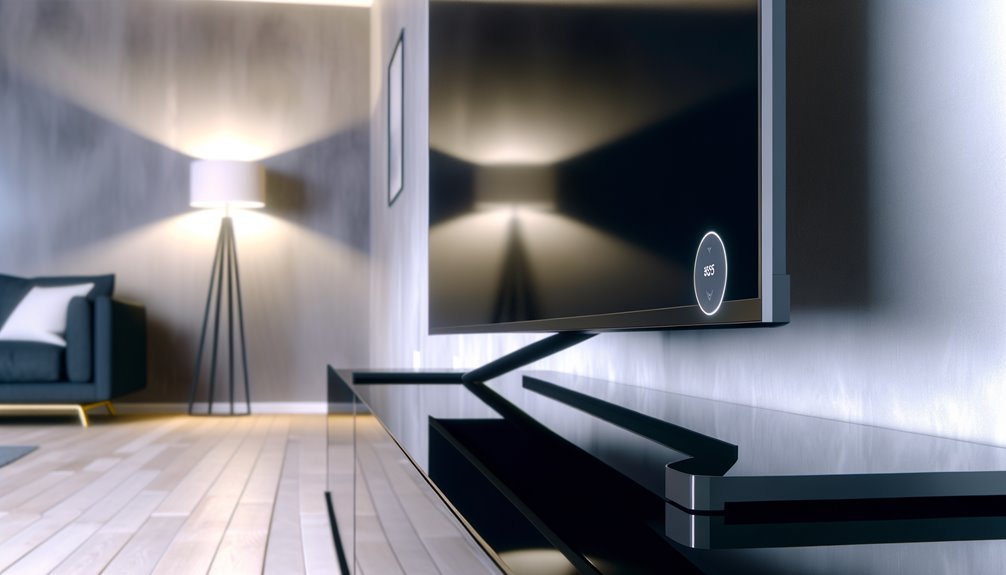For essential TV signal quality, go with an RG-6 coaxial cable. It’s designed to handle high-frequency signals, minimising interference and signal loss.
Look for a 75-ohm impedance rating and make sure it has both foil and braid shielding to block EMI and RFI.
High-quality connectors, preferably brass or gold-plated, will also enhance performance.
Top brands offer robust options, praised for their reliability and signal transmission efficiency.
Proper length selection is vital to avoid signal attenuation issues.
You’ll discover more detailed insights by exploring further.
Key Information
- RG-6 cables are highly recommended for robust TV signal transmission.
- Opt for 75-ohm impedance rating to ensure optimal TV performance.
- Ensure the cable has both foil and braid shielding to minimise interference.
- Gold-plated connectors provide superior and reliable connections for TV.
- If you require TV wall mounting, simply click the “Book Now” button and follow the steps to secure your appointment.
What Is a Coaxial Cable?
A coaxial cable is a robust, shielded cable specifically engineered for efficient data transmission, minimising signal interference and electromagnetic disruption.
You’ll recognise it by its thick, round shape, designed to maintain signal integrity over long distances.
The cable’s construction includes a central conductor, insulating layer, metallic shield, and outer jacket, which collectively resist electromagnetic interference (EMI).
When selecting a coaxial cable, consider factors like size, impedance rating, and air spaces within the cable, as these elements directly impact performance.
Coaxial cables are indispensable in applications like TV aerials, satellite dishes, internet connections, and digital video transmission, ensuring high-quality signal delivery.
Understanding these attributes guarantees you choose the best-suited cable for your specific needs.
Types of Coaxial Cables
When selecting coaxial cables, understanding the distinct specifications of RG-6, RG-11, and RG-59 is essential for ensuring peak performance across various applications.
RG-6 cables are your go-to for TV aerials, satellite dishes, internet, and digital video connections.
For high-definition TV (HDTV) and high-speed signal transfers, RG-11 cables excel.
If you’re setting up CCTV systems, RG-59 cables are specifically designed for that purpose.
Each type has distinct signal qualities and speeds, making the right choice crucial.
| Cable Type | Common Use | Ideal For |
|---|---|---|
| RG-6 | TV aerials, satellite | Internet, digital video |
| RG-11 | HDTV | High-speed signal transfers |
| RG-59 | CCTV systems | Short-distance video |
Key Features to Consider
To guarantee peak performance, prioritise coaxial cables with a 75-ohm impedance rating, as it aligns perfectly with TV signal requirements.
Shielding is essential; confirm your cable has both foil and braid shielding to minimise EMI (electromagnetic interference) and RFI (radio frequency interference).
For best signal transfer, select cables with low insertion loss, ensuring efficient transmission without significant signal degradation.
High-quality connectors, like brass or gold-plated, enhance conductivity and durability, providing a more reliable connection.
Finally, consider the length of the cable; shorter cables reduce signal attenuation and maintain signal integrity.
User Reviews and Recommendations
In examining user reviews and recommendations, you’ll find that RG-6 and RG-11 cables are frequently cited for their exceptional TV signal quality and reliability.
Users emphasise their robust shielding, minimal signal loss, and high-quality connectors like gold-plated or brass, which guarantee top performance.
While RG-6 is praised for general TV use, RG-59 cables receive accolades for CCTV systems. Many reviewers recommend considering cable length and shielding to avoid signal interference.
Below is a comparison table summarising key user insights:
| Cable Type | User Praise |
|---|---|
| RG-6 | Excellent TV signal quality |
| RG-11 | Outstanding reliability |
| RG-59 | Best for CCTV systems |
| Gold-plated connectors | Superior connection quality |
| Brass connectors | Durable and reliable |
These insights underscore the importance of selecting the right cable for your needs.
Frequently Asked Questions
Which Is Better RG6 or RG11?
You should choose RG6 for its flexibility and ease of installation in most setups. However, opt for RG11 if you need superior HD signal strength and lower signal loss over longer distances. Assess your specific requirements.
What Coax Cable Should I Use for My TV?
For peak TV performance, you’ll likely want to use RG-6 coaxial cable. It’s ideal for most domestic television setups, balancing signal quality and speed. However, if you’re focusing on high-definition signals, consider upgrading to RG-11.
What Is Best Coaxial Cable for HDTV?
For superior HDTV performance, you should use RG-11 coaxial cable. Its higher gauge supports robust HD signals, ensuring minimal signal degradation. Ideal for long-distance transmission, RG-11 offers superior reliability and crystal-clear viewing quality.
What Type of Coaxial Cable Is Recommended for Digital Television?
You should use RG-6 coaxial cable for digital television. Its versatility in connecting TV aerials, satellite dishes, and internet guarantees top performance. Make sure proper shielding, impedance, and connector quality to enhance signal reliability and viewing experience.
Conclusion
To summarise, understanding the specifics of coaxial cables—from their types and key features to top brands and user feedback—empowers you to make an informed choice for your TV setup.
Prioritise signal quality, durability, and compatibility to enhance your viewing experience.
With industry-leading options like RG6 and RG11, along with trusted brands, you’re equipped to select the best coaxial cable that meets your technical needs and guarantees excellent performance.
If you require TV wall mounting, simply click the “Book Now” button and follow the steps to secure your appointment.



